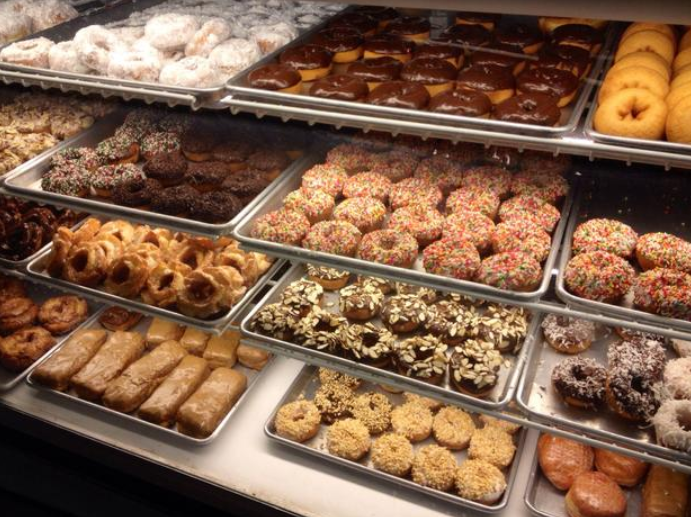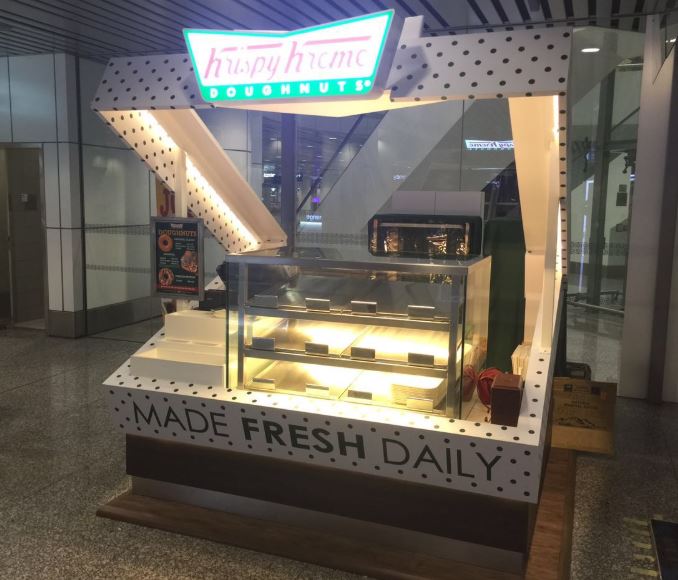The donut business is booming, and continues to grow year after year. According to a March 2018 report by IBIS World, the donut industry brings in about 16 billion (with a capital “B”) dollars each year, with large franchise chains like Dunkin’ Donuts, Krispy Kreme, Winchell’s and Tim Horton’s dominating the marketplace. It’s easy to see why; the margins on donut production and sales are off the charts, with ingredients costing just a few pennies on a product that can be sold for $2 or more.
Customer buying trends also show an increase in “small-scale luxury” purchases like donuts, and the industry trends toward creativity and gluten-free offerings continue to drive growth in the donut sector. Factor in coffee sales, another ridiculously high-margin item, and the donut business may start to make a lot of sense.
But how can smaller-scale food business entrepreneurs, who may not have hundreds of thousands of dollars laying around for franchise fees, buy into the extremely lucrative and ever-expanding donut biz? Here’s our complete guide to getting your donut operation, large or small, off and running:
Consider the location for starting your donut business.
Unlike outfitting a full-scale commercial kitchen, outfitting a retail store for donut-making requires much less space, though it does have its own equipment considerations (more on this later). For now, the biggest question is where you plan to put your donut business. Essentially, you’re starting a bakery with a smaller menu that doesn’t offer things like muffins, bagels, and similar goods.
You’ll need a few hundred square feet in retail space minimum to accommodate both the production area, and the sales area. Donuts sell best when they are artfully displayed, so plan on a large counter area for customers to see what you have available that day. A few tables for customers to sit and eat are nice, but not something you need to devote a lot of square footage to; most customers will take their orders to go.

Starting a donut shop? You have options.
Focus on one of two niches for your donut shop’s location: Do you want to be a charming/hipster donut shop, nestled in the heart of Main Street, where casual passers-by happen upon your shop and make an impulse buy? Or would a strip mall location make more sense, where customers short on time can pop in and grab a quick dozen while they’re running other errands? The type of shop you want to create will help dictate a lot of these decisions.
Donut shops are also a perfect fit for mobile concessionaires interested in jumping into the food truck game. With the right equipment, most of your initial donut production can be handled right on the truck, with expansion to a commissary kitchen a means for increasing the amount of product you create each day, as demand for your donuts grows. Staying mobile also allows you to bring the donuts to the people, where they need them the most; consider locations around large office complexes, public parks or waterfront locations, or near hospitals or universities. Remember that in a food truck or trailer, space is going to be at a premium, and this may have an impact on the variety and types of donuts you plan to create.
To franchise, or not to franchise.
One of the easiest ways to get started in the donut business, is by buying into a franchise such as Dunkin’ Donuts or Krispy Kreme. The franchise fees can be steep, often costing hundreds of thousands of dollars to get started. In exchange for paying this premium price, you’ll be working with an established brand who will handle much of your marketing for you, serving product shipped from a central supplier that you finish cooking in-house. Some franchises even help with real estate and construction questions and requirements.
Related Reading: 101 Famously Funny Donut Shop Slogans and Taglines
Many franchise opportunities offer a balance between the benefits of the support of the franchise system with the pride and freedom of independent ownership. If you have a background in entrepreneurship, baking or pastry (and you’re looking for limitless freedom in terms of the type and variety of products you sell), striking out with an independent venture may be more appropriate for your particular dreams and desires.
Donut Shop Equipment List
Different types of donuts require different kinds of equipment, and the kind of donuts you plan to sell will dictate a lot of these purchases and decisions. If you plan to sell strictly cake-style donuts, your initial equipment needs will be much simpler (and less expensive): a shallow fryer, a glazing table, and a batter dispenser are practically all you need to get rolling.
If you plan to sell “fancy” donuts (or what we in the business refer to as “raised yeast donuts”), you’ll need a little bit more: a shallow fryer, a glazing table, donut fryer, a large mixer, work surfaces for rolling out and cutting dough, rolling racks for storing donuts while in production, and a proofing box for letting the dough rise before frying. Of course, no matter what kind of donuts you make, you’ll also need refrigeration for your topping and filling ingredients, a hood or ventilation system over your fryers, and plenty of space for dry ingredient storage.
Your equipment purchases will also be dictated in part by the volume you think you’ll need to produce. If you plan to make a few dozen donuts each morning and call it a day, you’ll need smaller-scale countertop or freestanding floor fryers. If you’re going to be running your donut business full-bore, with round the clock production, a donut frying “robot” that can produce hundreds of donuts per hour may make the most sense.
Here’s a quick checklist of your initial equipment needs, with pricing from Webstaurantstore. Remember, you don’t need to purchase all of your equipment new; scouring local classified ads or Craigslist can help you unearth secondhand treasures at a huge savings. This is by no means an exhaustive list, but it may help you start to ballpark some figures:
- 150 lb Donut Floor Fryer: $8,500
- Rolling Donut Cooling Rack: $250
- Commercial Work Tables: $250/each
- Exhaust Hood System: $3,000 and up
- Donut Proofing Box: $800
- Donut Glazing Table: $1,000 and up
- 54″ Two-Door Refrigerator: $2,000
- 54″ Two-Door Freezer: $2,000
- Donut Robot Mark II: $8,500
- Cash Register / POS System: $1,000 – $2,000
If these figures seem intimidating, it’s because they are. If you don’t have a ton of startup capital to get your business off the ground, search for used restaurant equipment supply companies in your area, or opportunities for leasing or lease-to-own restaurant equipment.

Trays of Fresh Donuts.
Brainstorm creative ways to make money during your off-hours.
It makes sense that a donut shop would do a booming business first thing in the morning, but have you considered what 3 p.m. looks like in your fledgling donut shop? A business that only draws customers for a few hours per day doesn’t have much hope of hanging in for the long haul. Think of some ways for your business to continue earning during these slow periods. Special pricing on coffee in the afternoons can be a draw, depending on your location. Or look at Federal Donuts, a small chain based in NYC: Combining their fresh, creative donuts with a perfect piece of fried chicken drives massive sales numbers not just in the morning, but all day long.
You’ll also want to consider ways you can make money selling donuts, that may fall outside the normal scope of your daily donut shop business. Many donut shops supplement their core business by offering catering services for corporate functions or events, catering for weddings (donut wedding cake, anyone?), hosting or catering kid’s birthday parties, or hosting special meet-and-greets where customers can fry and decorate their own donuts.
Write a donut shop business plan.
Writing business plans is hard; that’s why so many entrepreneurs skip this step, and then run out of money three months into the launch of their new business. Assembling a business plan will help you methodically shape the vision for your donut shop into a concrete business, and working through the steps of composing a business plan will help you identify any potential issues with your idea before it starts to take shape. Business plans are also a critical component of selling other people on the merits of your idea, whether it’s a loan officer, an investor, or a sympathetic (and well-heeled) friend that may help with your initial funding needs.
Related Reading: 163 “How in One” Donut Shop Name Ideas
Start by writing your “executive summary,” which is a brief description of your concept, complete with mission statement. Next, you’ll write a description of your business, which will detail all of the areas in which your donut shop will be a success. Include a section for market research, which is where you analyze the marketplace in the community where you plan to open. You’ll want to consider competing donut shops already in business where you are, overall outlooks for the donut industry in general, as well as any strengths and weaknesses you can identify with your unique concept. This is also a good spot to include some general demographic data for your community, including population, household incomes, and ages of your potential customers.
Next, you’ll write a section on your marketing plan and projected sales. This is where you’ll outline your plan for marketing your donut shop, keep customers coming back, as well as where and how you’ll be selling your donuts. Finally, you’ll want a section for financial projections, which includes any details you can dig up on competing donut shops, your projected sales and cash flow, as well as any expenses you will incur from month-to-month.
Cost to Open a Donut Shop
You’ll need $100,000 – $150,000 on average to open a donut shop. Obviously, the square footage or size of the retail space you plan to open will also determine total startup cost. This includes purchasing equipment, leasing a retail space, setting up and paying for business licenses and permits.
How Much Will You Make Per Year with a Donut Shop?
The donut industry is valued at more than $16 billion dollars per year. According to 32 donut shop owners in the United States, I surveyed in the for this piece you can expect to make $125,000 – $250,000 in gross revenue per location. Keep in mind this is gross sales, not net profit.
Funding is a crucial step to opening a donut shop and it’s easier for some than others to get a low-interest loan. If you’ve got a solid nest egg saved up that you’re willing to gamble on your donut shop idea, this section isn’t for you. But what about those of us that need to raise the money needed (thanks to your carefully constructed business plan, you should have a ballpark figure in mind) to get started?
The first and most obvious place to start is with a business loan or a personal loan. Present the loan officer with your business plan, and be prepared to answer questions about every aspect of your proposed concept. Approach trusted friends and family members with your idea, as well as the total amount of money you need to raise, and see if they’ll pitch in, perhaps in exchange for a small amount of equity in the company. Seek out private small business startup investors in your area, and present your donut shop idea to them. You can even fund your new venture by maxing out your credit cards (it’s not recommended, but it happens more often than you might think), although remember that the interest rate and hit to your credit score will be considerable.
Lastly, consider crowdfunding your concept. Crowdfunding can be a great way to raise the capital to launch your new idea. Donuts are crowdfunding gold, because everyone craves them and they photograph beautifully. Begin with a short, professionally produced pitch video. Look directly into the camera, and speak from the heart; successful crowdfunding campaigns depend not just solely on the merits of your business idea, but on your ability to connect with potential contributors.
Plan a tiered system of rewards for contributors (making sure that you don’t promise too much; remember, if your crowdfunding campaign is a success, you’ll want to be launching your donut shop, not spending your limited time sending out thousands of custom t-shirts.
Find a hook that gives your crowdfunding campaign national appeal, rather than just the immediate community you will be serving; in your campaign video, describe your passion for donuts, your lifelong dream to be a small business owner, or the reasons why your late grandmother’s applesauce donuts are a legacy that’s important to preserve. Finally, share, share, share your campaign on Facebook, Twitter, printed on business cards, advertised on the radio, or with guest interviews on industry-related blogs and websites.

Donut shops can be operated out of trucks, kiosks, or retail locations.
Determine Business Entity
Here are the most common business entities used to start a donut shop. I always recommend reaching out to a lawyer in advance of creating the legal structure of your business. The right business structure can protect you financially and provide tax benefits to an organization.
- Sole Proprietorship: A sole proprietorship is the simplest business entity you can create. Many experts don’t advise this structure due to tax disadvantages and potential liability issues.
- Partnership: A partnership allows a more than one entrepreneur to share the risks of starting a business. But this structure also puts your personal finances and assets at risk if your business partner isn’t able to pay for their share of the startup expenses.
- LLC: A limited-liability company is one of the most popular structures for a donut shop. An LLC (in some cases) gives your personal assets protection from being seized in the event the business goes bankrupt or you are sued.
- Corporation: Donut shops are not usually structured as a corporation. Unless you plan to open up a franchise and have goals to open up hundreds of locations in the future this is usually not the most popular structure for an independent shop without goals for major expansion.
Acquire the necessary licenses, permits and certifications.
Begin with a phone call to your city or town’s code enforcement officer, and explain what kind of business you are interested in opening. He or she will provide you with a list of the licenses, certifications, and permits you will need to get the doors open and the list of inspections you’re required to pass. This process will vary from state to state, but you will probably need a license to do business from the state, and may need one at the city level as well.
You will also need to schedule a health inspection, and may need to take a food safety course, such as those offered by ServSafe. The Code Enforcement office can also help you coordinate with the Fire Marshall, for a potential inspection of your business prior to opening day. The hoops that you have to jump through may seem daunting, but remember that your city’s health inspector is there to help you; they want to make sure that none of your customers will be hurt or become sick, and it’s in your best interest to follow their instructions and recommendations to the letter.
Find suppliers for your ingredients and products. These vary widely from place to place; in general, try to find a local supplier for things like flour, sugar, and any specialized ingredients you’ll need for fancy toppings and fillings. Not only will a local supplier be priced competitively, but your customers will appreciate your support of a local business. A large distributor like Sysco can probably provide lower prices, but will require larger orders and may have less frequent deliveries to your area. Don’t forget to consider additional service items such as bags, napkins, boxes, and to-go containers for your donut and coffee service.
Plan your menu. This is one of the most fun parts of the process: brainstorming creative donut ideas that will get people talking about your business. You’ll want to come up with a few core, classic donuts to please customers that want something a little more simple or traditional. Once you’ve chosen a few of those, it’s time to get wild with over-the-top creations that customers won’t be able to find anywhere else, such as donuts topped with breakfast cereal, crumbled cookies, or donuts filled with unusual fillings like custard or even cookie dough.
When brainstorming ideas, use real-world reference points, and figure out how to translate them into donut form. Do you love peanut butter and jelly sandwiches? Try a raised yeast donut filled with with raspberry jelly and drizzled with peanut butter glaze. Cookies and milk? Experiment with a cookies-and-cream donut topped with cereal milk glaze and crumbled cookie pieces. The possibilities are limited only by your own imagination, and the more creative and interesting you can make your donut offerings, the likelier they are to generate customer buzz and organic social media shares.
Remember that coffee sales will be a major part of your business. At a minimum, you should sell hot brewed coffee, tea, juice, and milk, but you may also consider offering specialty coffees like cappuccino or espresso, or cold-brewed coffees for warmer climates.
Hire and train staff.
Your staffing needs will depend largely on the types of product you plan to sell, and the volume you need to produce. For example, simpler recipes like cake donuts can be taught to even the lowest-skill minimum wage workers; fancy filled raised-yeast donuts may require the skills of a higher-salaried pastry chef.
When you’re planning for your hiring needs, remember to account for things like employees calling in sick, taking time off, or using vacation time; for example, if you plan to be open for ten hours per day, five days per week, you don’t need one employee. You probably need more like three or four. Work with your bookkeeper or accountant to figure out the process for on-boarding these employees, including the structures for payroll tax withholding and worker’s compensation insurance.
Donut Shop Marketing
Design your donut shop space and signage, and be prepared to call in favors.
By now, you’ve probably got a pretty clear vision of what you want your donut shop to look like. Maybe you’ve even started mentally roughing out floor plans and design elements. Pinterest can be a great resource for exploring interior design ideas, to help you figure out the style and feeling you want your donut shop to have. Remember to design interior space not just for production, but for front-of-house considerations like counter service, donut display, point of sale, and a seating area for customers.
To save money, consider approaching friends or family for help, if anyone you know has a background in woodworking, electrical or plumbing work, or even interior design, logo, or web design. You may be surprised how many people you already know that would be willing to exchange their services for a lifetime supply of free donuts.
Begin marketing your business long before opening day.
Donuts and social media platforms go together like…well, donuts and social media. Delicious-looking donuts and over-the-top coffee creations are a natural fit for Instagram users, and you’ll want to establish a Facebook page for customers to ask questions, view your menu, and post reviews of your donut shop.
Many donut shop owners overlook the importance of social media marketing in their business plans. Don’t make the same mistake some local competitors make. The fact is donut shops are a gold mine for appealing food photos. Build taking photos of your boxed donuts into your daily operations. One good best practice is committing to publishing 2 social media updates each day.
Photos ideas to share on Facebook or Instagram include, pictures of donuts being removed from the fryer, smiling customers, mixing and cooking donuts in the morning, imagery from catering events, creative limited-time menu items and of course any discounts or specials you’re running.
You’ll also want to put together a simple web page, with a few glamor shots of some of your most creative donuts, your business address (with an accompanying map), and the different types of additional services you may offer, such as catering or corporate functions. Start this marketing early, to help generate buzz about your business before you open.

Open the doors and strap in. Remember, depending on your own level of experience in the foodservice business and the experience of your staff, opening day probably isn’t going to go the way you expect. Some of your equipment may not be performing as you’d expected, or you may run out of product sooner than you would have liked.
Something unexpected will inevitably go wrong, but it’s up to you and your team to weather the storm efficiently. Remember that most customers are understanding of opening day kinks, and will be patient if they see you working your way through them without panicking or losing your temper. Amid the chaos, remember to take the time to reflect and enjoy yourself; after all, opening the doors and serving your first donut is the culmination of a big dream and a lot of hard work, and you deserve a moment to revel in your newfound success.




